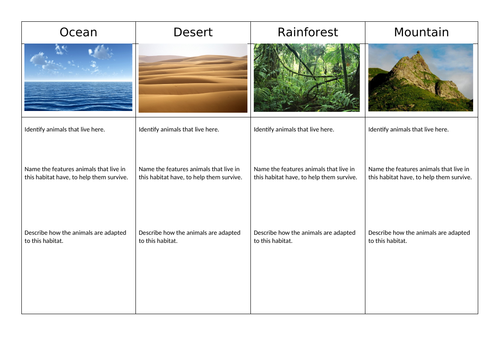











In this second lesson pupils should be taught to:
• Recognise that living things can be grouped in a variety of ways
• Use a keys, tables and diagrams to help group animals
• Identify and name a variety of living things from their local and wider environment
The following summary is based on notes and guidance from the National Curriculum.
The pupils will be classifying living things and presenting data in a variety of ways to help in answering questions, discussing their findings with peers and the staff. Instead of using written methods discussion could also be assessed through a snowballing activity, one student stays at the station and describes their ideas to other students as they rotate around the classroom.
The pupils can use the animal adaptation card sort to classifying vertebrate groups focusing on their features. The pupils can use the card sort activity if their knowledge of animals is limited, alternatively be provided with the blank table and prompts if there knowledge is more in depth. The pupils carry out simple comparisons using Venn diagrams to compare and contrast different animals with certain features. This builds upon the knowledge learned in lesson one and will reinforce how classification of different animals with backbones can be performed. This uses Ebbinghaus pedagogy theory about memory and current scientific research that repetition of the material in a different context or activity will aid memory retention.
The resources can be used as a stimulus to talk about criteria for grouping, sorting and classifying. They should begin to look for naturally occurring patterns and relationships between animals that share similar features.
The animal habitats activity can be used in conjunction with the animal cards. The students decided where the animals would live based on their features (adaptations). The activity gives the opportunity to describe / justify why they have decided each animal would be found in that habitat based on its features.
The last activity involves the use of Venn diagrams, they have been designed to allow pupils to compare and contrast animals based on their adaptations. These diagrams focus on the features of animals and the pupils can place the animal cards or animal pictures in the different regions. To save printing this activity can be used on the board and pupils simply copy the activity int their books. The Venn diagrams are a resource to assess the pupils knowledge and for them to record the similarities and differences and see which animals share certain features.
Something went wrong, please try again later.
This resource hasn't been reviewed yet
To ensure quality for our reviews, only customers who have purchased this resource can review it
Report this resourceto let us know if it violates our terms and conditions.
Our customer service team will review your report and will be in touch.